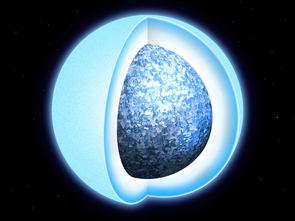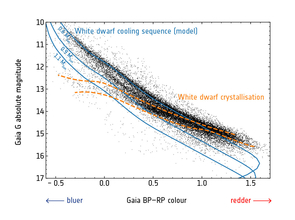Shedding light on white dwarfs – the future of stars like our Sun
17 May 2019
ESA's Gaia mission has been busy mapping our Milky Way galaxy since 2014, and just over one year ago released its second batch of data on more than one billion stars. Since then, astronomers have been exploring this catalogue to reveal a huge amount of new information about the cosmos. One type of object that has seen an abundance of new discoveries is white dwarfs.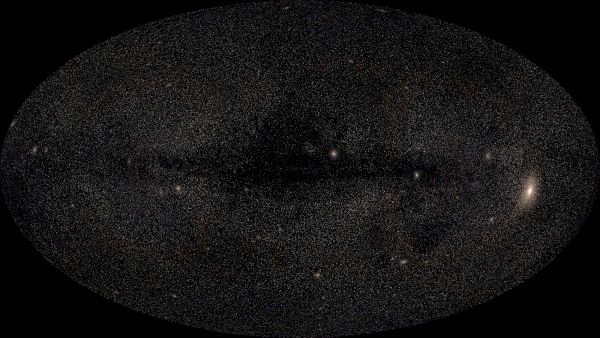 |
| Gaia white dwarf discoveries. Credit: ESA/Gaia/DPAC |
White dwarfs are the remnants left behind when medium-sized stars like our Sun reach the end of their lives. These stellar relics are extremely dense, with masses comparable to the Sun's confined to volumes comparable to that of Earth; just one cubic centimetre can weigh an incredible 1000 kilograms. Finding out more about white dwarfs gives us a peek into the future, showing us what the Sun will be like in five billion years' time, once it has exhausted the fuel powering nuclear fusion reactions at its core.
White dwarfs were discovered in 1910, when astronomers observed some mysterious objects that didn't fit with the then accepted model of stellar evolution. But it took almost 50 years to find as many as one hundred of them.
Until recently, just 30 000 white dwarfs had been discovered – a tiny number compared to the few hundred billion stars that are believed to exist within the Milky Way alone. And because they radiate only a small amount of lingering thermal energy as they slowly cool down, they are very faint and so it has been difficult to uncover much about them.
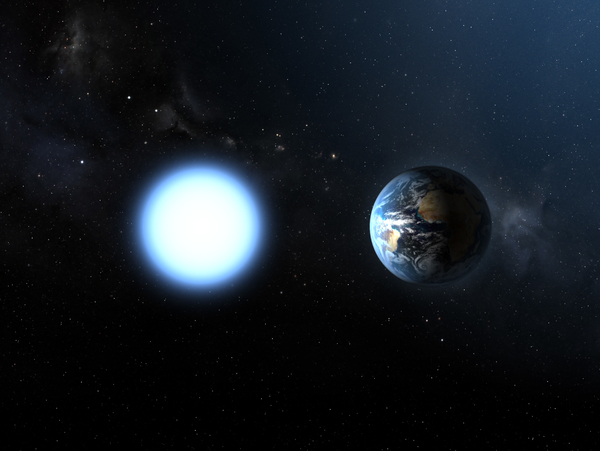 |
| A size comparison between Earth and Sirius B, the closest white dwarf. Credit: ESA and NASA |
Enter the Gaia era
Now, thanks to the game-changing second batch of data from Gaia, 486 641 white dwarf candidates have been detected, with 260 000 of these being high-confidence candidates, as reported in a catalogue compiled by Nicola Pietro Gentile Fusillo and collaborators. Discovering more of these mysterious objects enables us to gain better knowledge of their properties, improving our understanding of how they fit into the overall picture of stellar evolution.
"Thanks to Gaia's incredible ability to pinpoint the 3D position of huge numbers of stars, not only are we finding many more white dwarfs than we previously knew to exist, but our knowledge of their distances is hugely improving," explains Gaia scientist Stefan Jordan of Astronomisches Rechen-Institut, Zentrum für Astronomie in Heidelberg, Germany. "This allows us to decipher other properties of these stars better than we ever could in the past."
| The motions of 230 000 white dwarfs. (Click here for details and large versions of the video.) Credit: ESA/Gaia/DPAC |
The huge number of newly-discovered white dwarfs also means that many new classes and configurations have been revealed that didn't appear in the original 30 000. These include the first triple white dwarf system described in a paper by Marti Perpinyà-Vallès and colleagues: the triplet features three white dwarfs of the same age, which is strange if we consider that these objects are the relics of dead stars and therefore should all have formed at different times.
The Gaia catalogue includes lots of particularly cool white dwarfs, usually difficult to spot because they are so dim, as reported in studies led by Gustavo Ourique, Rodrigo González Peinado and Simon Blouin.
One of the most interesting discoveries to come out of this data release, made by Pier-Emmanuel Tremblay and collaborators, was the revelation that the cores of white dwarfs turn solid as they cool down, effectively forming extremely giant cosmic diamonds that are a million times denser than the Earth-based diamonds we are used to. This phenomenon was predicted 50 years ago by Hugh van Horn but little was understood about the process until Gaia data indicated white dwarfs release latent heat as they transform into crystals, slowing down the cooling process temporarily. The results suggest that after the Sun becomes a white dwarf in five billion years, it will take another five billion years for its core to turn solid.
White dwarfs inside out
The majority of white dwarfs are made up of mostly one element – typically hydrogen or helium, and in rare cases, carbon. But some have thick atmospheres, which can be polluted with heavier elements such as calcium, magnesium and iron. The new data contains information on previously-unknown polluted white dwarfs, the first of them announced in a research note by Carl Melis and collaborators; these objects are interesting because the polluting elements are thought to come from surrounding dusty disks or even unseen exoplanets or asteroids that have merged with the white dwarfs' outer layers.
Dusty disks can also lead to variability in the amount of infrared radiation that we receive from these stellar relics. One study led by Siyi Xu looked at Gaia observations of two white dwarfs that show such variability, suggesting that exoplanets could be disrupting the dusty disk.
Many new extremely low-mass white dwarfs have also been discovered in the new catalogue, as described in a paper by Ingrid Pelisoli and colleagues. The origin of these low-mass white dwarfs remains a mystery, and they don't fit with current models of stellar evolution. Finding more of them could help us better understand stars overall.
Furthermore, Gaia is enabling astronomers to study pulsating white dwarfs in greater detail. This special variety of white dwarf allows astronomers to carry out 'asteroseismology' research and study their interiors, just like seismology on Earth is used to understand the interior of our planet. Robert A. Stiller and collaborators used data from Gaia's second release to investigate the interaction between a pulsating white dwarf and its red-dwarf companion. Another study, led by Mukremin Kilic, looked for pulsations in white dwarf companions to millisecond pulsars, which are rapidly rotating, highly magnetised neutron stars – the endpoint of massive stars – and found pulsating emission from one such pair.
Near and far – white dwarfs across the Galaxy
The closest known white dwarf to Earth is Sirius B, companion of the brightest star in the night sky, Sirius A, only eight light years away. The Gaia data contained new information about Sirius A's dim companion, which were used by Simon R. G. Joyce and collaborators to improve our knowledge of the fundamental relationship between the mass and radius of white dwarfs.
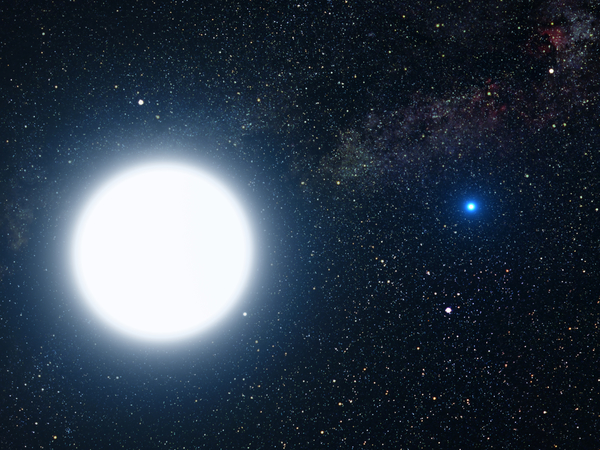 |
| An artist's impression of Sirius A and B. Credit: NASA, ESA and G. Bacon (STScI) |
White dwarfs are also advancing our understanding of the Milky Way as a whole. Because they cool at specific rates, they are good indicators of the age of different parts of the Galaxy. Using information from Gaia on more than 150 000 of the coolest and faintest white dwarfs, Mukremin Kilic and colleagues estimated the halo of stars surrounding the Milky Way to be about 11 billion years old, helping to pin down the evolutionary history of our galaxy.
Gaia is also providing new insight into the progenitors of white dwarfs. In particular, two papers led respectively by Jeffrey D. Cummings and Kareem El-Badry used the data to investigate the relationship between the mass of a star and the mass of the white dwarf that it eventually morphs into. It is expected that future releases of Gaia data will clarify this further, helping us predict the Sun's future in greater detail.
In a different study, Ken Shen and colleagues exploited Gaia's information not only on the position and distance of stars but also on their velocities across the Milky Way to find three white dwarfs that are zipping through our Galaxy at very high speeds. One possible interpretation sees these hyper-velocity white dwarfs as the survivors of a particular type of thermonuclear explosion, known as a type-Ia supernova. These explosions happen when a white dwarf pulls matter from a stellar companion in a binary system; in this particular case, the astronomers believe that the explosion happened in a system of two white dwarfs, causing one of the two stellar remnants to disappear and throwing the other away at speeds over 1000 kilometres per second. Gaia data on the motion of one of these speedy white dwarfs even hints at the existence of a supernova remnant.
| The hyper-velocity white dwarf D6-2. (Click here for details and large versions of the video.) Credit: ESA/Gaia/DPAC |
More excitement awaits white dwarf researchers. Based on Gaia data, Peter McGill and collaborators predicted that on 11 November 2019 a nearby white dwarf will pass in front of a more distant star. The white dwarf's gravity will deflect and magnify the background star's light, acting as a gravitational lens: this unique opportunity will allow astronomers to determine the white dwarf's mass. Until and after then, scientists will keep working with existing data from Gaia and other surveys to slowly but surely unveil the many mysteries of white dwarfs.
"Since Gaia was designed with 'galactic archaeology' as its main priority, we always expected that the mission would make ground-breaking discoveries in a diverse range of areas in astronomy," concludes ESA's Gaia deputy project scientist, Jos de Bruijne. "It is extremely rewarding to witness such a large contribution to white dwarf science from this latest data release."
A huge amount remains to be discovered about white dwarfs, but with Gaia, we are deciphering these fascinating objects one step at a time.

